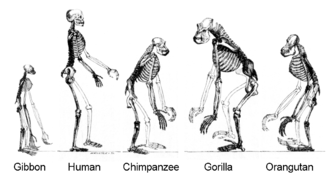
Back Menslike evolusie Afrikaans मानव केरऽ विकास ANP تطور الإنسان Arabic Evolución humana AST Antropogenez Azerbaijani اینسان تکامولو AZB Evoluzion vo da Menschheid BAR Антрапагенез Byelorussian Еволюция на човека Bulgarian মানব বিবর্তন Bengali/Bangla

Human evolution is the evolutionary process within the history of primates that led to the emergence of Homo sapiens as a distinct species of the hominid family that includes all the great apes.[1] This process involved the gradual development of traits such as human bipedalism, dexterity, and complex language,[2] as well as interbreeding with other hominins (a tribe of the African hominid subfamily),[3] indicating that human evolution was not linear but weblike.[4][5][6][7] The study of the origins of humans, variously known by the terms anthropogeny, anthropogenesis, or anthropogony, involves several scientific disciplines, including physical and evolutionary anthropology, paleontology, and genetics.[8][9]
Primates diverged from other mammals about 85 million years ago (mya), in the Late Cretaceous period, with their earliest fossils appearing over 55 mya, during the Paleocene.[10] Primates produced successive clades leading to the ape superfamily, which gave rise to the hominid and the gibbon families; these diverged some 15–20 mya. African and Asian hominids (including orangutans) diverged about 14 mya. Hominins (including the Australopithecine and Panina subtribes) parted from the Gorillini tribe (gorillas) between 8 and 9 mya; Australopithecine (including the extinct biped ancestors of humans) separated from the Pan genus (containing chimpanzees and bonobos) 4–7 mya.[11] The Homo genus is evidenced by the appearance of H. habilis over 2 mya,[a] while anatomically modern humans emerged in Africa approximately 300,000 years ago.
- ^ Britannica.com: Human Evolution
- ^ Brian K. Hall; Benedikt Hallgrímsson (2011). Strickberger's Evolution. Jones & Bartlett Publishers. p. 488. ISBN 978-1-4496-6390-2.
- ^ Cite error: The named reference
:3was invoked but never defined (see the help page). - ^ Cite error: The named reference
Ackermann 2015was invoked but never defined (see the help page). - ^ Antrosio, Jason (August 23, 2018). "Denisovans and Neandertals: Rethinking Species Boundaries". Living Anthropologically. Archived from the original on August 1, 2020. Retrieved August 25, 2018.
- ^ Human Hybrids Archived August 24, 2018, at the Wayback Machine. (PDF). Michael F. Hammer. Scientific American, May 2013.
- ^ Yong, Ed (July 2011). "Mosaic humans, the hybrid species". New Scientist. 211 (2823): 34–38. Bibcode:2011NewSc.211...34Y. doi:10.1016/S0262-4079(11)61839-3.
- ^ Heng, Henry H.Q. (May 2009). "The genome-centric concept: resynthesis of evolutionary theory". BioEssays. 31 (5): 512–525. doi:10.1002/bies.200800182. ISSN 0265-9247. PMID 19334004. S2CID 1336952.
- ^ Marlowe, Frank W. (April 13, 2005). "Hunter-gatherers and human evolution". Evolutionary Anthropology: Issues, News, and Reviews. 14 (2): 54–67. doi:10.1002/evan.20046. S2CID 53489209.
- ^ Tyson, Peter (July 1, 2008). "Meet Your Ancestors". Nova ScienceNow. PBS; WGBH Educational Foundation. Archived from the original on March 8, 2021. Retrieved April 18, 2015.
- ^ Gibbons, Ann (June 13, 2012). "Bonobos Join Chimps as Closest Human Relatives". TimeTree. Archived from the original on September 13, 2021. Retrieved May 19, 2018.
Cite error: There are <ref group=lower-alpha> tags or {{efn}} templates on this page, but the references will not show without a {{reflist|group=lower-alpha}} template or {{notelist}} template (see the help page).
© MMXXIII Rich X Search. We shall prevail. All rights reserved. Rich X Search